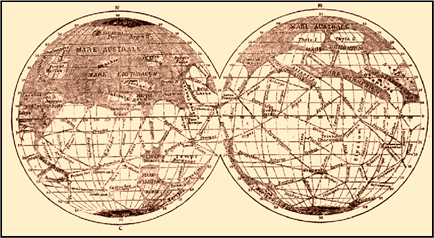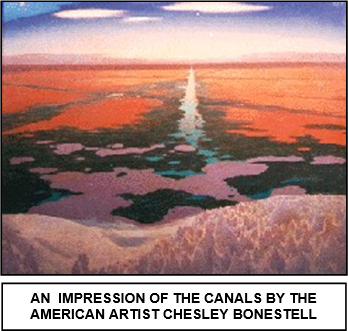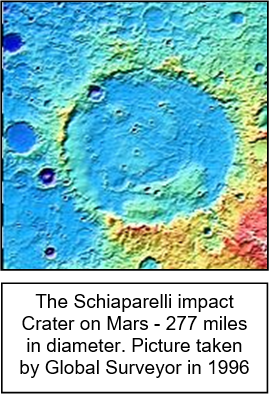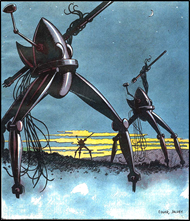


xxxxxThe Italian astronomer Giovanni Schiaparelli discovered a curious network of straight lines when he began a study of the planet Mars in 1877. He called them canali (channels), but this word was taken to mean canals and opened up a great deal of speculation. Many observers, particularly the American astronomer Percival Lowell, thought them to be irrigation canals made by intelligent beings. Schiaparelli favoured a natural explanation, but kept his options open. Eventually, early in the 20th century, more powerful telescopes proved that these lines had simply been an optical illusion. Schiaparelli also showed an interest in the planets Mercury, Venus and Uranus, but his most important contribution to astronomy was the discovery that all meteor showers are fragments of disintegrating comets. This earned him the Gold Medal of the Royal Astronomical Society in 1873. He discovered the asteroid Hesperia in 1861.
GIOVANNI VIRGINIO SCHIAPARELLI 1835 -
 xxxxxGiovanni Virginio Schiaparelli, the astronomer who aroused so much interest in the planet Mars, was born in Savigliano, Italy, and studied astronomy at Turin and Berlin until 1856. After serving as assistant observer at the Pulkovo Observatory, near St. Petersburg, in 1860 he took up a similar post at the Brera Observatory in Milan and remained at this establishment until his retirement in 1900, becoming director in 1862.
xxxxxGiovanni Virginio Schiaparelli, the astronomer who aroused so much interest in the planet Mars, was born in Savigliano, Italy, and studied astronomy at Turin and Berlin until 1856. After serving as assistant observer at the Pulkovo Observatory, near St. Petersburg, in 1860 he took up a similar post at the Brera Observatory in Milan and remained at this establishment until his retirement in 1900, becoming director in 1862.
xxxxxIt was in 1877, following the installation of a more powerful 8.6-
 xxxxxIt was while drawing up this map that he noticed what appeared to be a curious network of straight lines on the surface of the planet and this “discovery” set off a wave of speculation. He called these linear markings canali, meaning channels, but the likeness to the word “canals” was enough to feed the imagination. On planet Earth this was the age of the man-
xxxxxIt was while drawing up this map that he noticed what appeared to be a curious network of straight lines on the surface of the planet and this “discovery” set off a wave of speculation. He called these linear markings canali, meaning channels, but the likeness to the word “canals” was enough to feed the imagination. On planet Earth this was the age of the man-
xxxxxSchiaparelli was more cautious in his appraisal of the matter. He leaned towards a natural explanation, but he did not entirely rule out the possibility that these channels were artificial. The fact that they were drawn with such geometric precision did tend to suggest that they were the work of intelligent beings. “I am very careful, “ he wrote, “not to combat this supposition, which includes nothing impossible”. And by giving names of rivers to some of these canali, (such as Phison from the Garden of Eden, Lethes from Hades, and Ganges from India) he himself contributed -

xxxxxButxby the early years of the 20th century serious doubts were being voiced about the existence of these lines. The Greek astronomer Eugene Antoniadi (1870-
xxxxxControversy over the existence of canals on Mars has tended to overshadow Schiaparelli’s research in other directions. Whilst his study of Mars and the map he produced were of value, his most important contribution to astronomy was the discovery that all meteor showers are fragments of disintegrating comets. This earned him the Gold Medal of the Royal Astronomical Society in 1873, and the installation of a more powerful telescope at the Brera Observatory. The latter enabled him to turn his attention to the planets, including Mercury, Venus and Uranus. He also made a study of binary stars, and discovered the asteroid Hesperia in 1861. After his retirement in 1900 he wrote L'astronomia nell'antico testamento, a work tracing the astronomy of the ancient Hebrews and Babylonians.
xxxxxIncidentally, the first map of Mars was made by the German astronomers Wilhelm Beer and Johann von Madler in 1840, but they did not name the features. In 1858, however, the Italian astronomer Pietro Secchi (1818-
 xxxxx…… Perhaps not surprisingly, the science fiction novel The War of The Worlds, produced by the English futurist writer H.G. Wells in 1897, is centred around an invasion of England by Martians -
xxxxx…… Perhaps not surprisingly, the science fiction novel The War of The Worlds, produced by the English futurist writer H.G. Wells in 1897, is centred around an invasion of England by Martians -
xxxxx…… Before Schiaparelli began his study of Mars in 1877 he went into training. He avoided everything which could affect the nervous system, such as narcotics and alcohol. He also found that coffee was “exceedingly prejudicial to the accuracy of observation”. ……
xxxxx…… Schiaparelli’s niece, Elsa Schiaparelli, became a famous couturier after opening a fashion house in Paris in 1929.
Vb-


